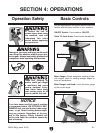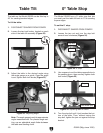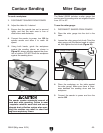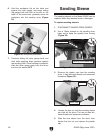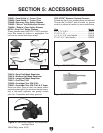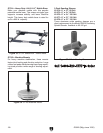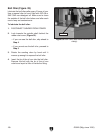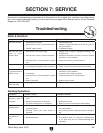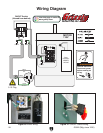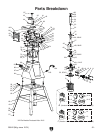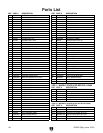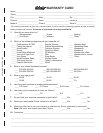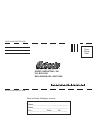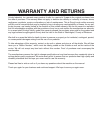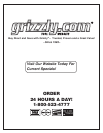
G9922
-29-
Review the troubleshooting and procedures in this section to fix or adjust your machine if a problem devel-
ops. If you need replacement parts or you are unsure of your repair skills, then feel free to call our Technical
Support at (570) 546-9663.
SECTION 7: SERVICE
Troubleshooting
Motor & Electrical
Symptom Possible Cause Possible Solution
Motor will not start. 1. Disabling key removed.
2. Open circuit in motor or loose connections.
3. ON/OFF switch at fault.
1. Insert disabling key.
2. Inspect all lead connections on motor for loose or
open connections.
3. Test/Replace switch.
Motor will not start;
fuses or circuit
breakers blow.
1. Short circuit in line cord or plug.
2. Short circuit in motor or loose connections.
3. Incorrect fuses or circuit breakers in power
line.
1. Inspect cord or plug for damaged insulation and
shorted wires.
2. Inspect all connections on motor for loose or shorted
terminals or worn insulation.
3. Install correct fuses or circuit breakers.
Motor Overheats 1. Motor overloaded.
2. Air circulation through the motor restricted.
1. Reduce load on motor.
2. Clean off motor to provide normal air circulation.
Motor stalls (result-
ing in blown fuses or
tripped circuit).
1. Short circuit in motor or loose connections.
2. Low voltage.
3. Incorrect fuses or circuit breakers in power
line.
4. Motor overloaded.
1. Inspect connections on motor for loose or shorted
terminals or worn insulation.
2 Correct the low voltage conditions.
3. Install correct fuses or circuit breakers.
4. Reduce load on motor.
Machine slows down
when operating.
1. Applying too much pressure to workpiece. 1. Feed workpiece slower with less pressure.
Symptom Possible Cause Possible Solution
Deep sanding
grooves or scars in
workpiece.
1. Sanding sleeve too coarse for the desired
finish.
2. Workpiece sanded across the grain.
3. Too much sanding force on workpiece.
1. Use a finer grit sanding sleeve.
2. Sand with the grain.
3. Reduce pressure on workpiece while sanding.
Grains rub off the
sanding sleeve.
1. Sanding sleeve has been stored in an incor-
rect environment.
2. Sanding sleeve has been folded or
smashed.
1. Store sanding sleeve away from extremely tempera-
ture and humidity.
2. Store sanding sleeves separately and not folded or
flat.
Sanding surfaces
clog quickly or
burn.
1. Too much pressure against sleeve.
2. Sanding softwood.
1. Reduce pressure on workpiece while sanding.
2. Use different stock. Or, accept the characteristics
of the stock and plan on cleaning/replacing belts
frequently.
Sanding Operations



